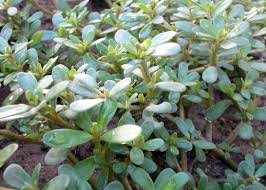Kulfa / Purslane bhurji
Hi friends ! Looking for an easy yet tasty Kulfa/Purslane recipe? Learn how to make Kulfa/ Purslane Bhurji using healthy ingredients.We love Kulfa ki bhurji . Kulfa / Purslane has thick and spongy leaves, and reddish stems, both of which are edible.
Botanical name : Portulaca Oleraceaa
Indian name : Kulfa
Although purslane is considered a weed in the United States, it may be eaten as a leaf vegetable. It has a slightly sour and salty taste and is eaten throughout much of Europe, the middle east, Asia, and Mexico. The stems, leaves and flower buds are all edible. Purslane may be used fresh as a salad, stir-fried, or cooked as spinach is, and because of its mucilaginous quality it also is suitable for soups and stews. Australian Aborigines use the seeds to make seedcakes. Greeks, who call it andrakla (αντράκλα) or glystrida (γλυστρίδα), use the leaves and the stems with feta cheese, tomato, onion, garlic, oregano, and olive oil, add it in salads, boil it or add to casseroled chicken. In Turkey, besides being used in salads and in baked pastries, it is cooked as a vegetable similar to spinach. In Albania it is also is used as a vegetable similar to spinach, mostly simmered and served in olive oil dressing, or mixed with other ingredients as a filling for dough layers of byrek. In the south of Portugal (Alentejo), “baldroegas” are used as a soup ingredient.
Names of this green leafy vegetable in other languages:
- Bengali: Lunia, Bara Lunia
- Hindi: Kulpha, Khursa,
- Gujarati: Luni bhaji
- Maharashtrian: Ghol
- Tamil: Pachiri
- Telugu: Gangapaayala, Peddapaayala, Payala kura, Peddapaavila aaku koora, Goli Kura
- Kannada: Doddagoni Soppu
- Arabic: Ba’le, Bakli, Farfhin, Arnuba, Bighal, Barabra (Maghrib), Rijl, Rujila, Al-hamqa, Al-baqla, Badalqa, Kharqa
- Armenian: Perper
- English: Purslane, Garden purslane, Pigweed, Hogweed
- French: Pourpier potager
- Greek: Glystiritha, Andrakln
- Italian: Portulaca, Porcellana, Perchjazza (Bari, Apulia)
- Spanish: Verdolaga
- Turkish: Semizotu, Temizlik (Aksaray Province)
- Urdu: Kulfa ki bhaji
Purslane / Kulfa is actually a super food. High in omega 3 fatty acids, purslane also possesses a variety of other nutritional benefits. Making appearances in farmers’ markets and even fancy restaurants, purslane should also become a household staple, as it is a potent health remedy.
What is Purslane?
Often labeled as a “weed,” purslane is actually a succulent herb. The plant is formally known as portulaca oleracea and less affectionately called little hogweed. The plant looks similar to the common jade plant and generally has fleshy, round leaves growing from a thin stalk.
The flavor components alone are often enough to make individuals try the herb. The leaves are the most important part of the plant and offer a moisture-rich bite similar to the crispness of a fresh cucumber. The leaves also render a note of lemony tang with a bit of a peppery finish.
Taste is not the only reason to eat this plant, however. It is considered by many as “a miracle plant.” Purslane / Kulfa literally has the highest level of omega 3 fats than any other green plants. It also boasts an assortment of other vitamins and nutrients.
Ingredients :
- 500 gms Kulfa / purslane, washed and finely chopped
- 2 Medium size onions, finely chopped
- 4 tbsp Chana dal / Bengal gram split
- 1/4 tsp Asafetida / hing
- 1 tsp salt
- 1 level tsp Red Chili powder
- 3 tbsp Olive oil or any other cooking oil
Method:
Step 1.
Heat the oil in a wok / kadahi / pan add asafetida / hing, sauté for few seconds till turns pink.
Step 2.
Add onions and fry onions in hot oil. When onions turn light golden, add Kulfa / Purslane, washed Chana dal / Bengal gram split, red chili powder and salt.
Step 3.
Mix well, sauté for a minute. Cover and cook on low flame till Chana dal / Bengal gram split is well cooked. Switch off the stove.
Step 4.
Serve hot with steamed white rice or any Indian bread of choice.
Health Benefits of Kulfa / Purslane:
In addition to its nearly 400mg of omega 3 fatty acids per serving, purslane also offers a variety of other nutrients.
The tender, leafy plant also possesses a number of nutrients including vitamin A, vitamin C, vitamin E, iron, calcium, manganese, magnesium, and potassium.These nutrients make the plant an effective herbal refreshment for health and wellness.
Its high concentrations of omega 3 fats make it an effective treatment for boosting heart health, lowering blood pressure and cholesterol, and controlling symptoms of attention deficit-hyperactivity disorder (ADHD) and autism.
Its nutrient profile also make it an effective treatment for diabetes, asthma, migraines, and osteoporosis.
The herb can even prevent cancer, promote skin health and boost immunity.
While labeled by the U.S. Department of Agriculture as a “noxious weed,” Kulfa / purslane is actually a beneficial health supplement. Above all, it is a taste and treat combination !
Ref. http://www.earthclinic.com/herbs/purslane.html
Nick’s kitchen medical Disclaimer:
- Nick’s kitchen is for Vegetarians. It sometimes provides education and support to individuals who want to become vegetarian, or move toward a more vegetarian diet.
- Nick’s kitchen provides some information on vegetarian and vegan diets to the best of their knowledge and abilities.
- Nick’s kitchen does not claim to be health care professional, nutritionist, nor does it claims to treat any illness through vegan or vegetarian diet.
- If you have a medical condition,Nick’s kitchen recommend that you consult your health care professionals before changing your diet.
- Any changes that you make to your diet, and the results of those changes, are your decision and your responsibility.



Hi, We Are Commercially Growers & Producer.
For more Details
LikeLike